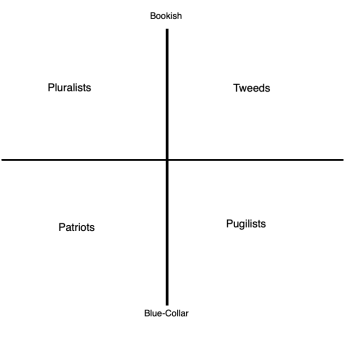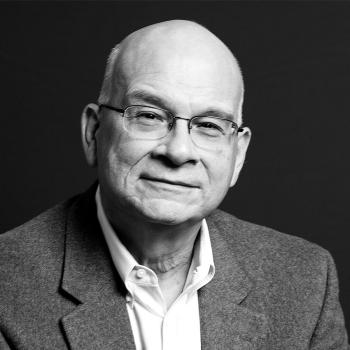
A few weeks ago, I found myself reading a recent essay by New York Times columnist Ross Douthat—and it’s a good one. In fact, I’d say it’s one of the most interesting pieces he’s penned in quite some time.
Here, he argues a position that (as he acknowledges) goes well beyond the theories advanced in his own book Bad Religion: How We Became A Nation of Heretics. In Douthat’s updated telling, the American socio-religious zeitgeist is evolving (or, to be more historically precise, regressing) towards a kind of pantheism, one that conceives of the world itself as essentially divine. This “God,” however, is in no sense personal: he/she/it is an undefined Ultimate Presence.
This is a narrow quibble with Douthat’s telling, but I would distinguish pantheism (the world is God) from panentheism (the world is interpenetrated by God, but God is not exhausted within the world). This distinction informs how one understands God’s relationship to temporal change. On the pantheistic account, changes in the world are changes within “God”—steps on a journey towards an ever-developing cosmic unity. On the panentheistic account, God is not determined by the world, but neither does he determine it directly (that is, as a discrete causal agent among other causal agents of the same sort). Variations of this latter position are commonly articulated by Eastern Orthodox, and some Catholic, Christian writers.
Anthony Kronman, whom Douthat mentions (and whose Confessions of A Born-Again Pagan was one of the more interesting books I read last year), probably leans towards panentheism. Despite his obvious affinity for Baruch Spinoza’s work, Kronman stretches at every step toward a discourse of transcendence and immutability—what he conceives of as the “eternality of the world.” This is hard to square with the language of constant change and growth.
Why might this distinction matter? A more truly pantheistic—evolutive, that is—view of divinity underpins the plausibility of alternative spiritualities: if there really is “something else” out there, some supernatural force that can be accessed within the everyday, witchcraft and séances and other old practices become live options, even within an ostensibly “secular” age. (By contrast, the panentheistic God—the immutable Absolute—is not so manipulable.)
The archetypal example of Douthat’s argument here is Jeffrey Kripal’s Authors of the Impossible: The Paranormal and the Sacred. Kripal (a professor of religious studies at Rice University) stakes out a bold position: to the modern mind, encounters with the very real supernatural cannot be conceived of as encounters with a personal God (or with the demonic). Instead, they must be categorized as “paranormal”—deviant occurrences outside the scope of everyday science, but that theoretically could be subject to scientific analysis. That is to say, the entire category of the “paranormal” has developed in recent centuries as an alternative way of describing the miraculous (or the abyssal).
But elsewhere, I think, Douthat’s narrative misses the mark.
Most notably, Douthat draws a line between “American civil religion” and the neo-pantheism he describes. But it is difficult to argue seriously that American civil religion—the same discourse described by Supreme Court Justice William Brennan as “ceremonial deism”—rests on essentially pagan metaphysical premises, rather than on a deracinated notion of Christianity. As longtime atheist litigant Michael Newdow clearly grasps, the motto In God We Trust clearly conveys some philosophical substance beyond mere wonder at nature.
Indeed, the Declaration of Independence itself speaks of the “laws of nature and of nature’s God” without conflating the two—a conflation reflected in Spinoza’s famous pantheistic aphorism Deus sive Natura (God or Nature). The American political experiment, at least in its early manifestations, was centered on transcendent principles of liberty and equality that do not change or develop with time. Now, one can certainly argue (as Patrick Deneen and others have) that this spartan theology doomed the nation’s cultural prospects from the start, but that is quite different from suggesting that it reflected a neo-pantheistic philosophy.
Furthermore, Douthat suggests towards the end of his column that today’s proponents of neo-pantheism “need to create a more fully realized cult of the immanent divine, an actual way to worship, not just to appreciate, the pantheistic order they discern.” I wonder, however, if the pantheistic religious indicia Douthat envisions may in fact already be here. Indeed, it seems to me that such language is positively ubiquitous.
In a provocative 2017 article, commentator Andrew Sullivan posed the question “Is Intersectionality A Religion?” By “intersectionality,” Sullivan refers to the distinctive argot of identity, privilege, and oppression that pervades contemporary cultural criticism. (I feel obligated to note that there’s no universally accepted descriptor for this pattern of speech and analysis—“Cultural Marxism” is too conspiratorial, “social justice discourse” is too oblique, and “postmodernism” is too imprecise”—but I suppose “intersectionality” is as good a term as any.) Instead of getting into an extended list of -isms and -phobias, it seems to me that intersectionality’s proponents are primarily united by opposition to “kyriarchy.” That term, initially coined by feminist theologian Elisabeth Schüssler Fiorenza, refers to “a complex pyramidal system of intersecting multiplicative social structures of superordination and subordination, of ruling and oppression.” The language of intersectionality, in turn, is targeted toward the dismantling of kyriarchic systems.
When Douthat’s account of neo-pantheism is factored in, the distinctively theological aspects of this way of thinking come into clearer relief. Progress towards the deconstruction of kyriarchic systems is progress towards a universal cosmic unity that transcends the binaries and distinctions used to oppress—a Kingdom of God, so to speak, on earth. Crucially, the “God” at the center of this quasi-theology is a denatured, ever-changing abstraction, one that remains wholly immanent to the earthly progress of justice and that stands in no ultimate superiority relation to creation.
Despite a superficial embrace of diversity and difference, there is a certain tragic irony in this neo-pantheistic way of thinking when carried to its logical conclusion. It can lead to the result that all differentiation is only conceivable as a form of, or precursor to, oppression. The Xenofeminist Manifesto, an online text that first circulated in 2015, proclaims that “the viability of the projects aiming for the abolition of class, gender, race and geography hinges on a profound reworking of the universal. The universal must be grasped as generic. Genericity slices through every particular, refusing the classification of bodies and lands.”
In other words, the ultimate destiny of humanity—the final emancipation—becomes an asymptotic vanishing point of utter sameness. In this eschatology, one understands what is meant by the “violence of metaphysics”: the total annihilation of one’s individual particularity. (Contrast this with the Christian framing, in which the personal God views the creation and declares it good—in all its difference, strangeness, and wildness.)
In time, the abolition of difference must entail a rejection of humanity itself. Transhumanism is the logical next step. In the words of the Manifesto, “‘Nature’ shall no longer be a refuge of injustice, or a basis for any political justification whatsoever! If nature is unjust, rebuild a new nature from scratch!” The neo-pantheistic vision—one that began with reverence before nature—becomes, at the end of all things, its total annihilation. For what could be less “natural” than the transhuman ideal?
To be sure, the language associated with intersectionality does not always foreshadow these consequences. Many insights associated with this form of analysis have proven valuable. But it is hard to deny that an undercurrent of religious zeal is sometimes present when these concepts are deployed; the Manifesto taps into some real and powerful intellectual trends.
And perhaps most fascinatingly, these trends don’t actually reflect a new pattern of religious thought. Rather, they implicate a very old one.
















